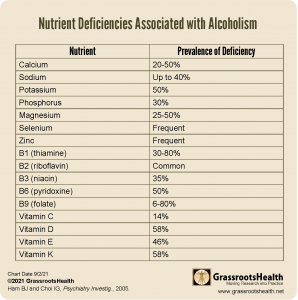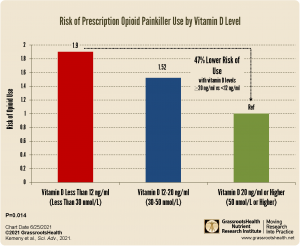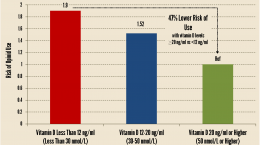Published on September 16, 2022
Key Points
- Substance misuse and overdose has become a growing crisis, especially since the beginning of the COVID-19 pandemic
- Alcoholism is the most common cause of magnesium imbalance; one study showed that the higher the intake of alcohol, the lower the magnesium and selenium levels, indicating that no matter how much alcohol is consumed, any amount may affect the status of these two essential elements
- A study found an inverse, dose-dependent association between vitamin D levels and self-reported opioid use, independent of pain, with decreased frequency of opioid use among individuals with higher vitamin D levels, and a 47% lower risk of opioid use among those with a vitamin D level of 20 ng/ml (50 nmol/L) or higher compared to those with levels below 12 ng/ml (30 nmol/L)
 National Recovery Month is recognized in September to promote and bring awareness to evidence-based treatment and recovery practices, recovery communities, service providers, and others who collaborate to make successful recovery from alcohol and drug addiction possible.
National Recovery Month is recognized in September to promote and bring awareness to evidence-based treatment and recovery practices, recovery communities, service providers, and others who collaborate to make successful recovery from alcohol and drug addiction possible.
Substance misuse and overdose has become a growing crisis. Alcohol use has especially risen due to the COVID-19 pandemic; one study on adults in the United States indicated a large increase in alcohol intake during COVID, with 1/3 of their participants having reported binge drinking and 7% reporting extreme binge drinking over the study period. The use of opioid drugs has also risen over the most recent couple of years during the COVID-19 pandemic, making it increasingly important to identify avoidable risk factors for opioid dependence and abuse.
Attention to Nutrients is Required with Current and Past Use
Both drug and alcohol intake can lead to deficiencies in several nutrients. Alcohol use in particular is known to deplete specific nutrients in the body.
Nutrients Affected by Drinking Alcohol
 In fact, alcoholism is the most common cause of magnesium imbalance. One study showed that the higher the intake of alcohol, the lower the magnesium and selenium levels, indicating that no matter how much alcohol is consumed, any amount may affect the status of these two essential elements.
In fact, alcoholism is the most common cause of magnesium imbalance. One study showed that the higher the intake of alcohol, the lower the magnesium and selenium levels, indicating that no matter how much alcohol is consumed, any amount may affect the status of these two essential elements.
Chronic alcohol intake is also associated with low levels of zinc, folate, B vitamins, and vitamin C.
Deficiencies of fat soluble vitamins A, D, and E have also been reported as more likely being deficient among alcoholics compared to non-alcoholics, especially among those with liver and/or pancreatic disease. One study in particular found that 58% of heavy alcohol drinkers had deficient levels of vitamin D (below 20 ng/ml or 50 nmol/L).
Read More About How Drinking Alcohol Affects Specific Nutrients
Low Vitamin D Levels Can Increase Risk of Opioid Use and Addiction
 In order to evaluate vitamin D deficiency as a contributing factor to opioid addiction, a study by Kemeny et al. used data from the National Health and Nutrition Examination Survey (NHANES, 2003-2004) to group individuals by vitamin D level and compare vitamin D levels to opioid use. They found an inverse, dose-dependent association between vitamin D levels and self-reported opioid use, independent of pain, with decreased frequency of opioid use among individuals with higher vitamin D levels, and a 47% lower risk of opioid use among those with a vitamin D level of 20 ng/ml (50 nmol/L) or higher compared to those with levels below 12 ng/ml (30 nmol/L).
In order to evaluate vitamin D deficiency as a contributing factor to opioid addiction, a study by Kemeny et al. used data from the National Health and Nutrition Examination Survey (NHANES, 2003-2004) to group individuals by vitamin D level and compare vitamin D levels to opioid use. They found an inverse, dose-dependent association between vitamin D levels and self-reported opioid use, independent of pain, with decreased frequency of opioid use among individuals with higher vitamin D levels, and a 47% lower risk of opioid use among those with a vitamin D level of 20 ng/ml (50 nmol/L) or higher compared to those with levels below 12 ng/ml (30 nmol/L).
Another analysis looked at the risk of Opioid Use Disorder (OUD) and how it was related to the presence or history of vitamin D deficiency. This time, the authors used data from 163,531 primary care patients, among which 2772 OUD cases were identified and matched to 8265 controls. They found that patients with OUD were much more likely to have vitamin D insufficiency or deficiency (levels below 20 ng/ml or 50 nmol/L), where 28% of OUD cases had a most recent vitamin D level below 20 ng/ml, versus only 17% of controls (P<0.001). OUD cases were also less likely to have a vitamin D level of at least 30 ng/ml (75 nmol/L) and were more likely to have had vitamin D deficiency compared to controls.
Read More About the Connection between Opioid Addiction and Vitamin D
Could Recovery be Aided by Addressing Nutrient Deficiencies?
Research has shown that addressing certain nutrient deficiencies can help improve mood disorders that are often associated with addiction. Could addressing nutrient deficiencies also help with addiction and the recovery process?
What is Your Nutrient Status?
Measure your:
- Vitamin D
- Magnesium PLUS Elements
- Omega-3 Fatty Acids
- hsCRP
Did you know that each of the above can be measured at home using a simple blood spot test? As part of our ongoing research project, you can order your home blood spot test kit to get your levels, followed by education and steps to take to help you reach your optimal target levels. Start by enrolling and ordering your kit to measure each of the above important markers, and make sure you are getting enough of each to support better mood and wellbeing!
Build your custom kit here – be sure to include your Omega-3 Index (Only or with Ratios), Magnesium PLUS Elements, and hsCRP along with your vitamin D.
Start Here to Measure Your Levels






